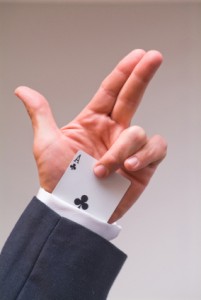
Have you ever gone into a store knowing exactly what you wanted, and then you suddenly get to the checkout counter with way more than you thought you needed? This happens to consumers all the time because stores use specific techniques to get you to pick up more than you need. One technique may not be very noticeable, and it probably wouldn’t affect you at all by itself. However, a combination of techniques could be very influential, and should be avoided if you want to save money.
Tricks of the Trade
It can be easy to fall into the traps stores set to make you spend more, but if you know what to look for, it will be easier for you to fight back.
- Popular Departments – The most desirable departments in a store are usually located as far away from the entrance as possible. May shoppers go to the store just to buy bread, milk, laundry detergent, etc., so then they have to walk through the entire store to get to that one item. With this strategy, we spend time walking by other merchandise in the store, and we are more likely to pick up something we hadn’t intended on buying that day.
- Impulse Items – Most stores place a great amount of items near the checkout counter. As shoppers prepare to check out, they may have to wait in line. These items are definitely not necessary, but because we spend so much time waiting and looking at the magazines, overpriced candy, and new DVD releases, we are more likely to buy them on an impulse.
- Product Location – The most expensive version of an item is always going to be placed at the eye level of the customer. Stores do this because we are more likely to pick up whatever item we see first. The bulk or less expensive items are usually placed on the bottom shelves.
- “Sale” Items – Sometimes, products are placed in a display as though they are on sale when they are not. The display will probably have a large sign above the items showing the price, but it will not actually say the item is on “sale”. The price is probably just the same as always, but the big display grabs our attention and makes us think we are getting a deal. Usually, these types of displays are used for the most expensive brands in the store.
- Blocking Traffic – The only time we add items to our cart is when we stop, so stores are designed to make us stop as much as possible. Aisles are only small enough for two carts, colorful and attractive displays grab our attention, and sample vendors make us want to stop and taste something new. Every time we stop, we are more likely to put something into our cart.
How Can I Fight Back?
Now that you are aware of some of the tricks stores use, you will be more likely to recognize these techniques while you are shopping and be able to avoid them. If you feel like you may need a little more help, here are a few ways you can actively fight back.
- Don’t use a cart if at all possible. Most of the time, we end up using carts as a place to put things we don’t need.
- Make a shopping list. This will help you focus on what you really need.
- Only look at prices and sizes. Everything else is just marketing. Find which item has the best price for the size and choose that one.
- Look at the bottom shelf first. Like I said, that’s usually where the least expensive items are placed.
- Finally, look through everything you have right before you check out. If you don’t feel like you need something, give it to the cashier and they will put it back. Don’t feel guilty or obligated to buy everything you have in your cart. You are the customer, and you shouldn’t have to buy something you don’t want.
Amy Young is the author of articles relating to business, marketing, and tips to save money. Her company tries to educate people about their personal finances through websites, including topics such as secure credit card resources.
If you’re struggling to pay off debt, ACCC can help. Schedule a free credit counseling session with us today.





